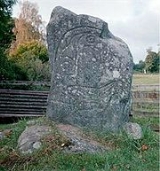
Clach an Tiompain
Encyclopedia
The Clach an Tiompain or The Eagle Stone is a small Class I Pictish stone
located on a hill on the northern outskirts of Strathpeffer
in Easter Ross
, Scotland
.
and is 32 inches (81.3 cm) high, 24 inches (61 cm) wide, and 10 inches (25.4 cm) thick. Carved on the southeast side are two images, a horse shoe-like arc
symbol above an eagle
.
battle that took place in 1411 between the Clan Munro
and a branch of the Clan MacDonald
, and that the stone commemorates a Munro victory as it is marked with their symbol, an eagle.
The stone is associated with the prophecies of the 16th century Brahan Seer
. He predicted that if the stone fell three times, the surrounding valley would be flooded, and the stone used as an anchor.
It has since fallen twice, and is now set in concrete.
Pictish stones
Pictish stones are monumental stelae found in Scotland, mostly north of the Clyde-Forth line. These stones are the most visible remaining evidence of the Picts and are thought to date from the 6th to 9th centuries, a period during which the Picts became Christianized...
located on a hill on the northern outskirts of Strathpeffer
Strathpeffer
Strathpeffer is a village and former spa town in Ross and Cromarty, Highland, Scotland, with a population of 1,469.-Geography:It lies in a glen 5 miles west of Dingwall, with varying elevation from 200 to 400 feet above sea level...
in Easter Ross
Easter Ross
Easter Ross is a loosely defined area in the east of Ross, Highland, Scotland.The name is used in the constituency name Caithness, Sutherland and Easter Ross, which is the name of both a British House of Commons constituency and a Scottish Parliament constituency...
, Scotland
Scotland
Scotland is a country that is part of the United Kingdom. Occupying the northern third of the island of Great Britain, it shares a border with England to the south and is bounded by the North Sea to the east, the Atlantic Ocean to the north and west, and the North Channel and Irish Sea to the...
.
Description
The stone is made of blue gneissGneiss
Gneiss is a common and widely distributed type of rock formed by high-grade regional metamorphic processes from pre-existing formations that were originally either igneous or sedimentary rocks.-Etymology:...
and is 32 inches (81.3 cm) high, 24 inches (61 cm) wide, and 10 inches (25.4 cm) thick. Carved on the southeast side are two images, a horse shoe-like arc
Arc (geometry)
In geometry, an arc is a closed segment of a differentiable curve in the two-dimensional plane; for example, a circular arc is a segment of the circumference of a circle...
symbol above an eagle
Eagle
Eagles are members of the bird family Accipitridae, and belong to several genera which are not necessarily closely related to each other. Most of the more than 60 species occur in Eurasia and Africa. Outside this area, just two species can be found in the United States and Canada, nine more in...
.
History
The stone was originally located further down the hill, towards Dingwall, but was moved to its current site in 1411. One old tradition is that the stone marks the site of a Scottish clanScottish clan
Scottish clans , give a sense of identity and shared descent to people in Scotland and to their relations throughout the world, with a formal structure of Clan Chiefs recognised by the court of the Lord Lyon, King of Arms which acts as an authority concerning matters of heraldry and Coat of Arms...
battle that took place in 1411 between the Clan Munro
Clan Munro
-Origins:The main traditional origin of the clan is that the Munros came from Ireland and settled in Scotland in the 11th century and that they fought as mercenary soldiers under the Earl of Ross who defeated Viking invaders in Rosshire...
and a branch of the Clan MacDonald
Clan Donald
Clan Donald is one of the largest Scottish clans. There are numerous branches to the clan. Several of these have chiefs recognised by the Lord Lyon King of Arms; these are: Clan Macdonald of Sleat, Clan Macdonald of Clanranald, Clan MacDonell of Glengarry, Clan MacDonald of Keppoch, and Clan...
, and that the stone commemorates a Munro victory as it is marked with their symbol, an eagle.
The stone is associated with the prophecies of the 16th century Brahan Seer
Brahan Seer
The Brahan Seer, known in his native Scottish Gaelic as Coinneach Odhar. Some have questioned whether he really existed at all. He is thought to have come from Uig on lands owned by the Seaforths, and to have been a Mackenzie, although both these details are in themselves questioned...
. He predicted that if the stone fell three times, the surrounding valley would be flooded, and the stone used as an anchor.
It has since fallen twice, and is now set in concrete.

